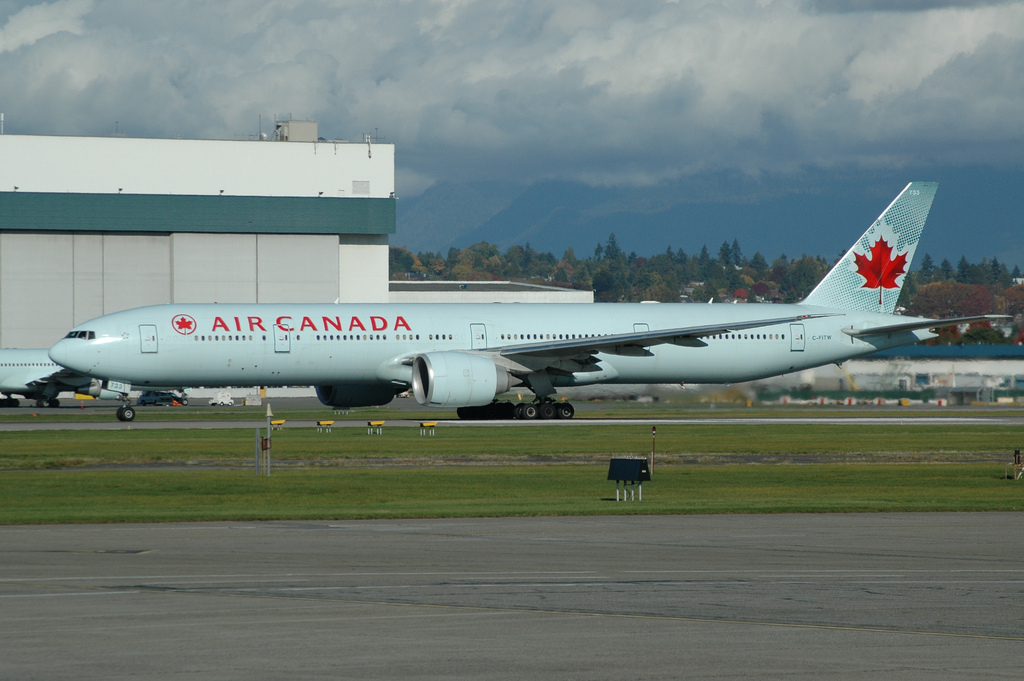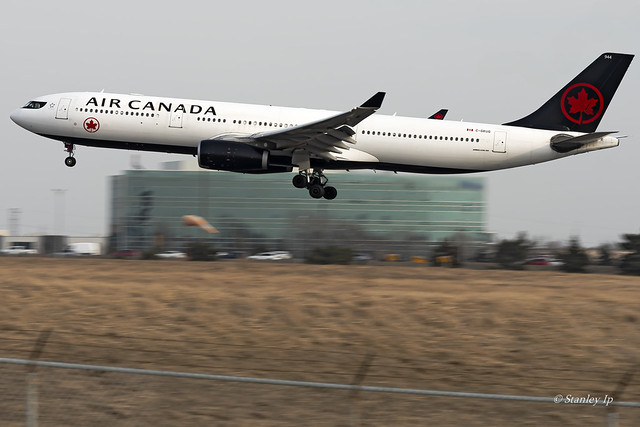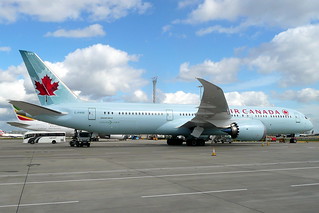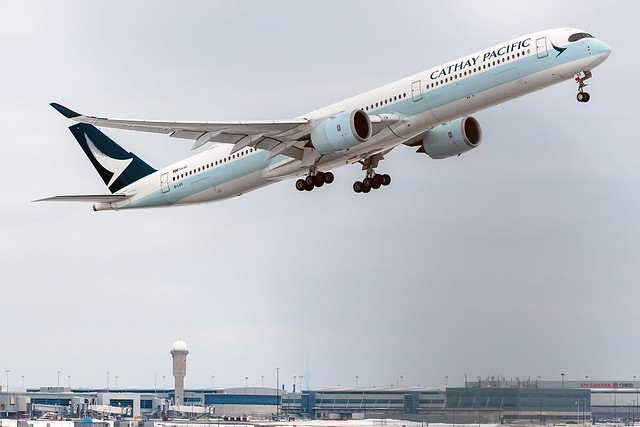Canada B773 at Hong Kong on Dec 11th 2018, tail strike on landing
Last Update: January 4, 2022 / 18:58:28 GMT/Zulu time
Incident Facts
Date of incident
Dec 11, 2018
Classification
Accident
Cause
Tail strike on landing
Airline
Air Canada
Flight number
AC-15
Departure
Toronto, Canada
Destination
Hong Kong, China
Aircraft Registration
C-FITW
Aircraft Type
Boeing 777-300
ICAO Type Designator
B773
Airport ICAO Code
VHHH
A post flight inspection revealed evidence of a tail strike.
The return flight was cancelled, the occurrence aircraft is still on the ground in Hong Kong about 39 hours after landing.
On Dec 13th 2018 the Canadian TSB reported the aircraft sustained a tail strike due to a hard landing causing structural damage requiring major repairs. The occurrence was rated an accident. Hong Kong's Air Accident Investigation Authority is investigating.
Hong Kong's Air Accident Investigation Authority (AAIA) released their preliminary report reporting the first officer was pilot flying from Top of Descent to landing, with the captain (ATPL, 22,375 hours total, 6,416 hours on type) also being rated Initial Operating Experience Training Captain (IOETC) assuming the role as pilot monitoring.
The AAIA wrote with respect to the first officer: "This flight was the first B777 operating flight for the FO, the first actual landing of a B777 outside of a B777 Level D flight simulator and the first arrival into Hong Kong as an operating crew member."
The AAIA reported the approach was stabilized though marginally above the glideslope. The first officer disconnected the autopilot at 400 feet AGL. Descending through 200 feet AGL several roll oscillations followed by a pronounced roll to the left and a roll to the right occurred as the pilot flying introduced large control inputs in response to unexpected roll behaviour. The aircraft touched down in right bank, the right main gear touched down first in a high nose up attitude at a high rate of descent, the underside of the fuselage contacted the runway surface, the aircraft bounced and returned onto the runway center line and rolled out without further incident.
The AAIA wrote: "Subsequent inspection of the underside of the rear fuselage indicated the aircraft sustained damage to the rear lower fuselage requiring major repair or replacement of the affected components. The aircraft is currently unserviceable and is undergoing a major repair process to rectify the lower fuselage damage prior to a return to operational service."
The Hong Kong Air Accident Investigation Authority (AAIA) released their final report concluding the probable cause of the accident was:
An unstable approach developed due to pilot induced lateral rolling oscillations which coupled with a high rate of descent resulted in an abnormal runway contact.
Contributing Factors
Stabilised Approach Criteria
The late recognition by the PM that the stabilised approach criteria after the second (500 ft) arrival gate was outside the required tolerances.
Pilot Flying PIO Onset Recognition
The over controlling (high gain) by the PF resulted in PIO. [3.1 (5)] There is no requirement for PIO onset recognition or recovery actions in the operator’s training procedures.
Go Around Decision
The late recognition by the PM that the aircraft was in an unstable flight condition that should have resulted in an “unstabilised” or a “go around” call from the PM and required an immediate go around.
The PF did not initiate a go around when the aircraft was in a PIO condition.
Pilot Flying Loss of Situational Awareness
Task saturation with the lateral oscillation and high gain corrections resulted in the high descent rate up to the runway contact point.
Pilot Monitoring Loss of Situational Awareness
Any decision to go around during the bounce was impeded due to the “startle effect”, which delayed any response or action.
The AAIA analysed:
First Officer (the PF)
The FO had recently been qualified on the Boeing 777, following eight weeks on a type conversion course from the narrow-body Embraer E190 to the wide-body Boeing B777. The Air Canada simulator conversion course which is approved by Transport Canada where the aircraft type rating is completed in the simulator before commencing the on-line training with an IOETC.
The FO completed the B777 aircraft type rating on the 6th December 2018.
This flight was the first B777 operating flight for the FO and the first actual landing of a Boeing 777. It was also the FO’s first arrival into Hong Kong as an operating crew member.
Training Captain (Pilot Monitoring - PM)
The IOETC was the pilot in command and training the FO as part of his line training. Although the FO was the PF the IOETC has overall responsibility for the safe conduct of the flight. The IOETC had operated into Hong Kong on previous occasions.
Pilot Flying Control Wheel Displacement (A)
There was minimal control wheel movement until the aircraft descended through approximately 200 feet radio altitude (RA) where the inputs start to increase in magnitude. Starting from approximately 80 feet RA the control wheel gain becomes full deflection to the left and right with increasingly rapid inputs. The PIO onset and the related control wheel movements exhibit high gain as the oscillation increases.
Peak Loading –“g” Load (C)
Peak loading at the initial contact with the runway was 3.56 g.
The aircraft rate of descent remained constant throughout with no attempt to check the rate of descent prior to the runway contact.
Flight Data Assessment
Due to the PIO, at the runway contact point, the aircraft was rolling 10° right with a rate of descent of 723 ft/min and a nose high pitch attitude of 6.8° which resulted in the right main landing gear contacting the runway followed by the left main gear concurrent with the rear fuselage contacting the runway surface.
This was followed by a high bounce, a marked bank to the right with runway contact occurring with the right main gear, another smaller magnitude bounce and eventual touch down initially on the nose wheel followed by the main gears.
Pilot Monitoring and Announcing Deviations during Approach
A high degree of discipline is required by both pilots during an approach.
The PM (the IOETC) is required to monitor the flight path, draw attention to any deviations from the normal flight path parameters and make the required height check calls.
Initially, the approach was within all the stable approach criteria and following the second arrival gate at 500 ft the autopilot was disconnected at 420 ft AAE.
After the PF disconnected the autopilot and flew manually the aircraft became slightly high on the glideslope.
Taking into account that this was the PF’s first landing on type, this was possibly an opportunity for the PM to provide some training input. Being aware that the aircraft was approaching the stable limits would also be a trigger to alert the PM that a go around might be imminent.
The stable approach criteria tolerances were reached in the event sequence when the oscillations started, which according to the operators operating manual20 required the PM (the IOETC) to alert the PF when a significant deviation is observed.
The PM (the IOETC) did not call for a go around when the onset of the oscillation was detectable. There was also an opportunity to take control at the recognition of the PIO.
Go Around Decision
The stabilised approach criteria tolerances are not subjective, the call for a go around should have occurred after the second 500 ft AAE arrival gate tolerances at the onset of the PIO lateral deviations.
Just prior to touchdown, with no flare initiation, when it became apparent that the approach had become unstable a decision could have been made to go around then. This could have been instigated either by the PF initiating it or the PM, or either of the relief pilots (RP) saying go around, or the PM taking control and conducting the manoeuvre.
Runway Contact
Preoccupied with the unexpected roll control deviations which distracted the PF from flaring the aircraft and arresting the high descent rate prior to the runway contact suggest that the PF was most probably experiencing task saturation. It appears that just before the initial runway contact the PF realised that there had been no flare input and made an abrupt back input on the control column, but this was ineffective in arresting the rate of descent at this stage.
Bounced Landing Recovery
During this occurrence a bounced landing recovery was achievable, the aircraft deceleration was normal, with no additional longitudinal stability issues contributing to an unstable landing recovery. The ability to conduct a go around after the bounce was an option but no call or action was taken by the PM or the PF to initiate one. There was no input from the other two crew members in the cockpit.
The decision not to go around during the bounce was probably also due to the “startle effect”, which is a human factor condition which leads to a delayed response and action to an unexpected situation.
To sum up, the sudden onset of the PIO at the end of a long haul flight took the crew by surprise due to recognised human factor behaviour when presented with an unexpected situation. The loss of situational awareness impeded the recovery of the event.
Metars:
VHHH 110800Z 33014KT CAVOK 18/10 Q1020 NOSIG=
VHHH 110730Z 34013KT 9999 FEW040 18/10 Q1020 NOSIG=
VHHH 110700Z 33016KT 9999 FEW040 18/10 Q1020 NOSIG=
VHHH 110630Z 33012KT 9999 FEW040 18/10 Q1020 NOSIG=
VHHH 110600Z 34011KT 9999 FEW028 18/10 Q1020 NOSIG=
VHHH 110530Z 33011KT 9999 FEW028 18/10 Q1020 NOSIG=
VHHH 110500Z 33012KT 9999 FEW025 17/10 Q1020 NOSIG=
VHHH 110430Z 34013KT 9999 FEW025 17/10 Q1021 NOSIG=
VHHH 110400Z 34011KT 9999 FEW022 18/10 Q1021 NOSIG=
VHHH 110330Z 34012KT 9999 FEW022 17/11 Q1022 NOSIG=
VHHH 110300Z 34013KT 9999 FEW022 16/11 Q1022 NOSIG=
Aircraft Registration Data
Aircraft registration data reproduced and distributed with the permission of the Government of Canada.
Incident Facts
Date of incident
Dec 11, 2018
Classification
Accident
Cause
Tail strike on landing
Airline
Air Canada
Flight number
AC-15
Departure
Toronto, Canada
Destination
Hong Kong, China
Aircraft Registration
C-FITW
Aircraft Type
Boeing 777-300
ICAO Type Designator
B773
Airport ICAO Code
VHHH
This article is published under license from Avherald.com. © of text by Avherald.com.
Article source
You can read 2 more free articles without a subscription.
Subscribe now and continue reading without any limits!
Read unlimited articles and receive our daily update briefing. Gain better insights into what is happening in commercial aviation safety.
Send tip
Support AeroInside by sending a small tip amount.
Related articles
Air Canada B773 at Toronto on May 28th 2012, dropped engine parts on departure
An Air Canada Boeing 777-300, registration C-FITW performing flight AC-1 from Toronto,ON (Canada) to Tokyo Narita (Japan) with 318 passengers and 16…
Canada A333 near Winnipeg on Oct 19th 2025, smoke from standby compass
An Air Canada Airbus A330-300, registration C-GKUG performing flight AC-327 from Montreal,QC to Calgary,AB (Canada) with 285 people on board, was…
Canada BCS3 at Denver on Aug 31st 2025, acrid odour in cabin
An Air Canada Bombardier C-Series CS-300, registration C-GYLQ performing flight AC-1038 from Denver,CO (USA) to Toronto,ON (Canada) with 117…
Canada BCS3 and United B38M at San Francisco on Jun 24th 2025, ATC operational error
An Air Canada Bombardier C-Series CS-300, registration C-GWUQ performing flight AC-760 from San Francisco,CA (USA) to Montreal,QC (Canada), was…
Canada BCS3 enroute on Jun 12th 2025, captain incapacitated
An Air Canada Bombardier C-Series CS-300, registration C-GNAM performing flight AC-1051 from Montreal,QC (Canada) to Austin,TX (USA) with 82 people…
Canada B789 near Frankfurt on Mar 25th 2025, hydraulic leak
An Air Canada Boeing 787-9, registration C-FRSE performing flight AC-57 from Dubai (United Arab Emirates) to Toronto,ON (Canada) with 304 people on…
Newest articles
Endeavor CRJ7 at Charlotte on Dec 22nd 2025, engine shut down in flight
An Endeavor Canadair CRJ-700 on behalf of Delta Airlines, registration N641CA performing flight DL-4827 from Charlotte,NC to Atlanta,GA (USA) with 68…
Cathay Pacific A35K at Hong Kong on Nov 26th 2025, tail strike during go around
A Cathay Pacific Airbus A350-1000, registration B-LXO performing flight CX-764 from Ho Chi Minh City (Vietnam) to Hong Kong (China), was landing on…
Subscribe today
Are you researching aviation incidents? Get access to AeroInside Insights, unlimited read access and receive the daily newsletter.
Pick your plan and subscribePartner

ELITE Simulation Solutions is a leading global provider of Flight Simulation Training Devices, IFR training software as well as flight controls and related services. Find out more.
SafetyScan Pro provides streamlined access to thousands of aviation accident reports. Tailored for your safety management efforts. Book your demo today
AeroInside Blog
Popular aircraft
Airbus A320Boeing 737-800
Boeing 737-800 MAX
Popular airlines
American AirlinesUnited
Delta
Air Canada
Lufthansa
British Airways





